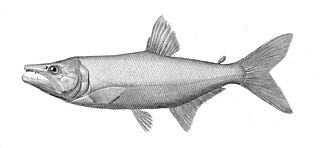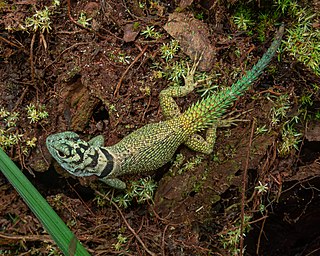
Acestrorhynchus is a genus of characiform fish found only in fresh water in South America, the sole genus in the family Acestrorhynchidae. Their greatest diversity is in the Orinoco and Amazon basins.

Ecpleopus is a genus of lizard in the family Gymnophthalmidae. The genus contains only one species, Ecpleopus gaudichaudii, which is endemic to Brazil.
Nothobachia is a genus of lizards. It is monotypic with Nothobachia ablephara as the sole species. It is endemic to Bahia state of eastern Brazil.
Stenolepis is a genus of lizard in the family Gymnophthalmidae, a family commonly known as microteiids or spectacled lizards. The genus Stenolepis contains a single species, Stenolepis ridleyi, commonly known as the Pernambuco teiid. The species is endemic to Brazil, and the common name refers to its type locality in Pernambuco state in northeast Brazil.

Portugal competed at the 1924 Summer Olympics in Paris, France.

Cyrtopodium, often abbreviated Cyrt in horticulture, is a genus of more than 40 species of epiphytic and terrestrial orchids found from Florida and Mexico through Argentina. Cyrtopodium is the only genus in the monotypic subtribe Cyrtopodiinae.
Aquascypha is a fungal genus in the family Meruliaceae. It is a monotypic genus, containing the single species Aquascypha hydrophora, found in Central and South America. This species forms cup-like structures with dimensions of 2.7 to 14.9 cm and heights of 6.1 to 18 cm. Study of this fungus in the Amazon rainforest showed that on average, these cups hold 35 millitres of water, in addition to organic matter such as leaves, flowers and fruits that fall from trees; this provides an ideal environment for various insect species to breed.
Knodus is a genus of characins, small freshwater fish from South America.
Lepidocharax is a genus of characins endemic to the Doce, Paraguaçu and São Francisco basins in eastern Brazil. They are small fish, that reach up to 4 cm (1.6 in) in standard length.
Phallobrycon is a genus of fish in the family Characidae endemic to Brazil.
Rhinopetitia is a genus of characins endemic to Brazil.
Stenocercus quinarius is a lizard found in Brazil.
Stenocercus squarrosus is a lizard found in Brazil.
Scriptosaura is a genus of the lizard family Gymnophthalmidae. The genus is monotypic, i.e. it has only one species, Scriptosaura catimbau. It occurs in Brazil.
Caparaonia is a genus of the lizard in family Gymnophthalmidae. The genus is monotypic, i.e. it has only one species, Caparaonia itaiquara. It is endemic to Brazil and is known from the Caparaó National Park on the border between Minas Gerais and Espírito Santo states.
Loxopholis ferreirai is a species of lizard in the family Gymnophthalmidae. The species is endemic to Brazil.
Stanley Howard Weitzman was a Research Scientist Emeritus at Division of Fishes, National Museum of Natural History, Washington, D.C.

Strobilurus torquatus is a species of lizard in the family Tropiduridae and the only member of the genus Strobilurus. This arboreal lizard is found in the Atlantic Forest in eastern Brazil, ranging from Rio de Janeiro to Ceará.




